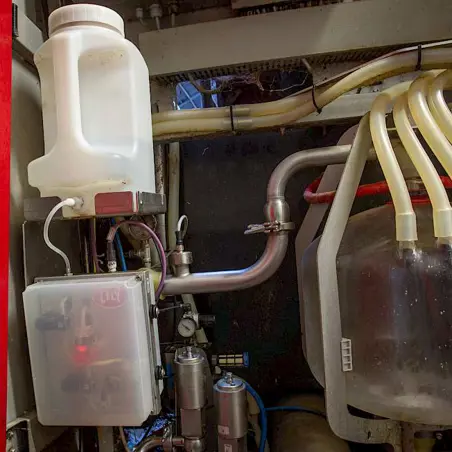Farming Insights
Our Farm Management Support specialists continuously investigate how to improve the milking process even further. They do this by running tests in the barn while using our customers’ knowledge of the Lely barn solutions. In this way they gain valuable insights, which help you to manage your dairy farm more efficiently and profitably.
Farming Insights
5 factors that influence hoof health 5/5
Proper nutrition strengthens hooves and boosts disease resistance. A balanced diet, especially during transition, supports to prevent energy deficits that can affect hoof health. Read more about how feeding strategies can support strong hooves and overall cow resilience.
In a series of five articles, hoof health expert André Janse, Farm Management Specialist at Lely, takes a closer look at this topic and shares valuable insights and practical tips.
Locomotion = Barn design + Hygiene & Climate + Preventive hoof care + Nutrition

5 factors that influence hoof health 4/5
Preventing hoof issues is better than treating them. Regular hoof care, combined with preventive measures like automatic spray bars or hoof baths, helps maintain healthy hooves. Explore how structured hoof care fits into daily farm management.
In a series of five articles, hoof health expert André Janse, Farm Management Specialist at Lely, takes a closer look at this topic and shares valuable insights and practical tips.
Locomotion = Barn design + Hygiene & Climate + Preventive hoof care + Nutrition

Farming Insights
17 articles
Filter results
5 factors that influence hoof health 5/5
Proper nutrition strengthens hooves and boosts disease resistance. A balanced diet, especially during transition, supports to prevent energy deficits that can affect hoof health. Read more about how feeding strategies can support strong hooves and overall cow resilience.
In a series of five articles, hoof health expert André Janse, Farm Management Specialist at Lely, takes a closer look at this topic and shares valuable insights and practical tips.
Locomotion = Barn design + Hygiene & Climate + Preventive hoof care + Nutrition

5 factors that influence hoof health 4/5
Preventing hoof issues is better than treating them. Regular hoof care, combined with preventive measures like automatic spray bars or hoof baths, helps maintain healthy hooves. Explore how structured hoof care fits into daily farm management.
In a series of five articles, hoof health expert André Janse, Farm Management Specialist at Lely, takes a closer look at this topic and shares valuable insights and practical tips.
Locomotion = Barn design + Hygiene & Climate + Preventive hoof care + Nutrition

5 factors that influence hoof health 3/5
Barn hygiene and climate can influence hoof health, especially when it comes to infectious skin-related diseases. Ventilation, light, and dry floors all play a role in maintaining a clean environment. Regular foot baths and proper care extend beyond dairy cows. Dry cows and young stock also need attention to prevent infections from spreading. Explore how barn conditions and routine care contribute to overall hoof health.
In a series of five articles, hoof health expert André Janse, Farm Management Specialist at Lely, takes a closer look at this topic and shares valuable insights and practical tips.
Locomotion = Barn design + Hygiene & Climate + Preventive hoof care + Nutrition

5 factors that influence hoof health 2/5
Free movement is key to a comfortable and productive barn. When cows have enough space to eat, rest, and move without obstacles, they experience less competition and stress. A well-designed barn benefits both cows and farmers. Sometimes, less really is more! Discover how barn layout impact dairy farming.
In a series of five articles, hoof health expert André Janse, Farm Management Specialist at Lely, takes a closer look at this topic and shares valuable insights and practical tips.
Locomotion = Barn design + Hygiene & Climate + Preventive hoof care + Nutrition

5 factors that influence hoof health 1/5
Cows spend their days eating, drinking, resting, and visiting the milking robot, activities that rely on strong legs and hooves. Read more about the role of locomotion in dairy farming!
In a series of five articles, hoof health expert André Janse, Farm Management Specialist at Lely, takes a closer look at this topic and shares valuable insights and practical tips.
Locomotion = Barn design + Hygiene & Climate + Preventive hoof care + Nutrition

Singeing Udders
When temperatures drop cows start to grow thicker hair to protect them against the winter cold. This makes them sweat, and excessive hair growth on the udder and tail may also impair robot efficiency. Cows’ tails are usually shaved mechanically using a shaver. There are two options for removing hair from the udder: shaving or singeing (flame clipping).

Liners, daily routines and maintenance
For an optimal milking process, we want to milk quickly (effective in time), gently (maintaining the comfort and well-being of the cow) and completely (milk out most of the available milk). To help achieve this optimal result, the liner choice, condition and maintenance are of major importance to this.

Lameness in dairy cows
This article provides more knowledge about the causes behind lameness and foot problems to help reduce the incidence of lameness and its associated costs.

The Lely MQC-C: a promising on-farm tool for udder health
The somatic cell count (SCC) is a common benchmark used in mastitis management. Testing of the SCC of composite cow milk should be done every 3 weeks to 6 weeks. Additional measurements between milk controls can help with the early detection of changes in udder health.
